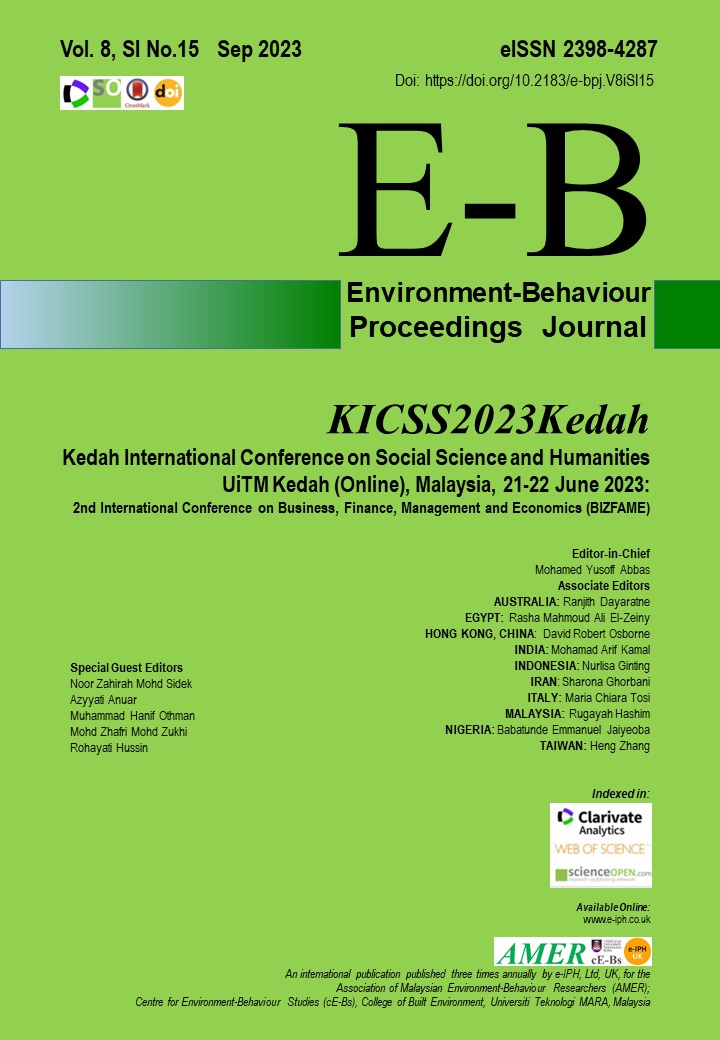Benefits of Implementing a Public Sector Conducive Ecosystem (EKSA): A case study of Tun Dr. Ismail Library, Universiti Teknologi Mara, Johor, Malaysia
DOI:
https://doi.org/10.21834/e-bpj.v8iSI15.5081Keywords:
5S, EKSA, Management Accounting, Higher Education Institutions LibraryAbstract
The Public Sector Conducive Ecosystem (EKSA) was established in 2014 to enhance the quality of work environments in the Malaysian public sector. Specifically, it involves rebranding the 5S practices that have traditionally been used to create a conducive workplace environment. This study has utilized a qualitative approach via interview as data collection to explore the benefits of adopting EKSA practices in a library located within a higher education institution in Malaysia. The study findings have revealed that implementing EKSA practices in the public sector can enhance productivity and cost efficiency and improve the working environment, particularly in developing countries.
References
Azevedo, J., Sá, J. C., Ferreira, L. P., Santos, G., Cruz, F. M., Jimenez, G., & Silva, F. J. G. (2019). Improvement of the production line in the automotive industry through lean philosophy. Procedia Manufacturing, 41, 1023-1030. DOI: https://doi.org/10.1016/j.promfg.2019.10.029
Bernard, R. H. (2012). Social research methods: Qualitative and quantitative approaches (2nd ed.). Sage.
Boon, P. (2015, August 31). Eksa to lead the way in innovation for the public sector. Borneo Post Online.
Chandrayan, B., Solanki, A. K., & Sharma, R. (2019). Study of 5S lean technique: a review paper. International Journal of Productivity and Quality Management, 26(4), 469–491. DOI: https://doi.org/10.1504/IJPQM.2019.10020993
Guest, G., Bunce, A., & Johnson, L. (2006). How many interviews are enough? An experiment with data saturation and variability. Field Methods, 18(1), 59-82. DOI: https://doi.org/10.1177/1525822X05279903
Hafizahfpm. (2019, November 04). Panduan EKSA-FPM. FLIPHTML5. https://fliphtml5.com/muemf/lwgl/basic
Hirano, H. (1995). 5 Pillars of the Visual Workplace. Productivity Press, Oregon. DOI: https://doi.org/10.4324/9781482278057
Lowe, A., Norris, A. C., Farris, A. J., & Babbage, D. R. (2018). Quantifying thematic saturation in qualitative data analysis. Field Methods, 30(3), 191–207. DOI: https://doi.org/10.1177/1525822X17749386
Michalska, J. , & Szewieczek, D. (2007). The 5S methodology is a tool for improving the organization—Journal of Achievements in Materials and Manufacturing Engineering, 4.
Noor Mohamad Shakil Hameed (2017). Ekosistem Kondusif Sektor Awam (EKSA): perkongsian amalan di Bahagian Hal Ehwal Pelajar, Universiti Putra Malaysia. Seminar Pragmatis 2.0 : Perkongsian Amalan Terbaik Dalam Pengurusan Universiti 2017. Universiti Sains Islam Malaysia.
Noor Mohamad Shakil Hameed (2017, January 17a). EKSA Perkasa Sektor Awam. Harian Metro. https://www.pressreader.com/malaysia/harian-metro/20170117/283527975513367
Norhaslina Jumadi, Nurul Sahida Fauzi, Lizawati Abdullah, Wan Nur Syazwani Wan Mohammad and Johana Yusof (2015). The Effectiveness of the Implementation of QE/5S towards Quality Environment at Workplace. Proceedings of Postgraduate Conference on Global Green Issues (Go Green) (p. 6). UiTM (Perak), Malaysia.
Sati, S. A., & Adam, A. I. (2019). Evaluating the effectiveness of 5S implementation in the industrial sector. International Journal of innovative science and research technology, 4(10), 804-808.
Unit Pemodenan Tadbiran dan Perancangan Pengurusan Malaysia (MAMPU) (2020, August 26). Ekosistem Kondusif Sektor Awam (EKSA). https://www.mampu.gov.my/ms/ekosistem-kondusif-sektor-awam-eksa
Universiti Teknologi MARA, Perpustakaan Tun Abdul Razak. (2021, May 18). EKSA. https://johor.library.uitm.edu.my/history/84-ptdi/about/189-eksa.
Vinod, M., Devadasan, S. R., Sunil, D. T., & Thilak, V. M. M. (2015). Six Sigma through Poka-Yoke: a navigation through literature arena. The International Journal of Advanced Manufacturing Technology, 81, 315-327. DOI: https://doi.org/10.1007/s00170-015-7217-9
Wan Asri Wan Ab Aziz, Nurlidaini Jaafar & Azman Che Mat (2015). Implementation of 5s practices at 3k elite schools in Terengganu. Academia Journal UiTMT, Volume 4 Issue 1, 7.
Zohrabi, M. (2013). Mixed method research: Instruments, validity, reliability, and reporting findings. Theory and practice in language studies, 3(2), 254. DOI: https://doi.org/10.4304/tpls.3.2.254-262
Downloads
Published
How to Cite
Issue
Section
License
Copyright (c) 2023 Siti Salimah Jalal, Mohamad Hafiz Rosli, Noraizah Abu Bakar, Noor Sufiawati Khairani

This work is licensed under a Creative Commons Attribution-NonCommercial-NoDerivatives 4.0 International License.





